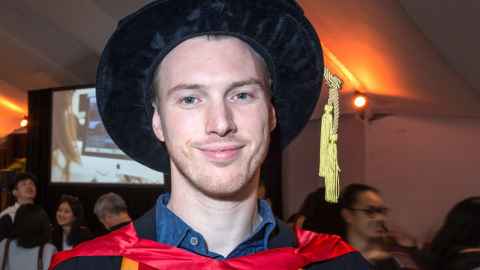Keeping science serious by avoiding the 'p' word
24 July 2018
Tom Bodey (Biological Sciences) talks about behaviour differences in individual animal species – but avoids talking ‘personality’ to keep his science serious.

The University of Auckland's Tom Bodey explains why scientists tend to shy away from words like ‘personality’ in an effort to be taken seriously.
Scientists want to communicate their research and ideas to as wide an audience as possible but this is not always easy, especially as we often need to apply caution and caveats to our research results. Many folk – such as the news media – like clear-cut, simple outcomes that are easily understood by non-scientists, particularly if they are going to generate an eye-catching, snappy headline.
But important as it is to appeal to a wide audience, it is also important that our work is taken seriously, that it is scientifically robust and meets standards of quality and efficacy. What this sometimes means in practice is that we avoid particular words and phrases that, while immediately recognisable in the everyday world, are problematic in science.
Scientists tend to shy away from words like ‘personality’. Instead, we use lots of other names for individual behavioural responses: behavioural syndromes; coping styles; behavioural tendencies - anything that avoids the dreaded ‘p’ word.
There are really good reasons for this. While we all love stories like Dr Doolittle, one of the great challenges in science is how to assess behaviour in non-human species in a way that is scientifically meaningful. It’s very hard to even begin to analyse the thought patterns of a rat for example, to understand what is going on in that furry non-human head. So the best method we have come up with is to examine a handful of behaviours in a group of individuals from a particular species and then observe how those individuals differ in their responses in various contexts.What we find is that individual animals often differ substantially, and consistently, in their behaviour. For example, some individuals from species as different as prawns, hyenas and albatross can be bolder, more active, or more social than others, and this variation can then affect other aspects of their lives such as what food they search for and where they look for it.
These differences are intriguing because they can be maintained throughout an individual’s lifetime, and also across generations, yet this stands in contrast to the idea that species will adapt through time towards a single optimal solution where they all eat or search for food in more or less the same way.
So, in order for variation to be maintained in any aspect of animals’ lives, there must be situations in which one set of behaviours are beneficial to those individuals that display them, as well as contrasting situations where other individuals that react differently will prosper instead.My work in invasive species research, funded by a Marie Skłowdowska-Curie Fellowship, looks at individual variation across a range of ecological niche dimensions in everyone’s favourite critter, the humble rat. An ecological niche refers to all the biological and non-biological elements – from climate to predators - that an individual experiences during its lifetime. Different aspects can help or hinder survival and reproduction, and examining different niche dimensions will help us to understand how individuals are trying to solve the puzzle of optimum survival in their particular ecological niche.
The Chinese recognise the rat as the first animal within their zodiac cycle, embodying alertness, spirit and intelligence (as well as being timid, devious and gossipy), all traits that, in people, we would instantly recognise vary between individuals. New Zealand is ‘blessed’ with three rat species – all invasive and globally widespread – the Brown/Norway Rat Rattus norvegicus, Black/Ship Rat R rattus and the Pacific Rat/Kiore R exulans.
I’ve been catching wild rats on offshore islands in the beautiful Hauraki Gulf and running them through behavioural trials in the field before releasing them in order to do it all again the next day and the day after that. You get the picture. My work aims to provide insights into ecological theory and will have applied applications for invasive species management, meaning we can use the results to help inform the work we do in the field on pest management.
New Zealand, like many oceanic islands, is in the position of having no native land mammals and thus can manage invasive mammals, should we choose to do so, using tools that may not be appropriate when both native and invasive land mammals coexist. If total eradication is not possible, triaging of the system, which would mean making adjustments to maximise the chances of catching the individuals with the greatest potential to cause harm, would be the most cost-effective solution.
But if eradication is the goal, then we still need to know whether there are individuals in any given population that will avoid our best attempts to remove them. Without the help of Dr Doolittle, our work is difficult and often laborious but if we want to save treasured native species such as kiwi, kakapo and hoiho from going extinct, then identifying individuals with a ‘troublemaking personality’ – as you might say, but a scientist never would – will be key to success.
Tom Bodey is an honorary academic in the University of Auckland’s Faculty of Science
Media enquiries:
Anne Beston l Senior Media Adviser
Communications Office
Tel: 09 923 3258
Mob: 021 970 089
Email: a.beston@auckland.ac.nz